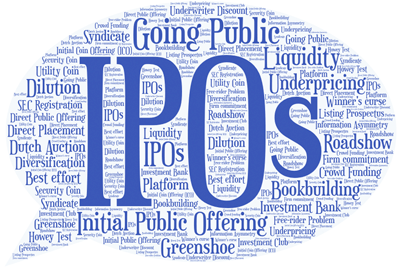What is an Initial Public Offering - IPO?
The process of offering shares in a private corporation to the public for the first time is called an initial public offering (IPO). Growing companies that need capital will frequently use IPOs to raise money, while more established firms may use an IPO to allow the owners to exit some or all their ownership by selling shares to the public. In an initial public offering, the issuer, or company raising capital, brings in underwriting firms or investment banks to help determine the best type of security to issue, offering price, amount of shares and time frame for the market offering.
KEY TAKEAWAYS
Some people refer to an IPO as a public offering or "going public." There are other ways to go public like a direct listing or direct public offering. When a company starts the IPO process, a specific set of events occurs. The chosen underwriters facilitate these steps.

IPO History
The Dutch are credited with conducting the first modern IPO by offering shares of the Dutch East India Company - often called VOC for short - to the general public. The company paid an annual dividend that ranged between 12% and 63% to its shareholders.
In modern times, IPOs have become a favored instrument of entrepreneurs to raise capital for future expansion. As a new industry gains prominence and its future prospects hyped by the media, startups in the sector capitalize by offering shares in their company to the public.
Companies in the technology sector are examples of this trend. Tech IPOs multiplied at the height of the dot com boom as startups without revenues rushed to list themselves on the stock market. 2008's financial crisis resulted in a year with the least number of IPOs. The market for IPOs has recovered since then but not so
Advantages of an IPO
The primary objective of an IPO is usually to raise capital for a business. However, a public offering has other benefits as well.
Some companies will conduct an IPO because of the prestige and credibility it imbues. This may be a factor for future lenders who might be more willing to make loans at more favorable terms if they know the company has a diversified shareholder base and is accountable to the SEC for accurate financial reporting. However, the real value of intangible advantages like prestige are difficult to measure.
Disadvantages of an IPO
An IPO is expensive, and the costs of maintaining a public company are ongoing and usually unrelated to the other costs of doing business. There are other disadvantages of an IPO as well.
Having public shares available requires significant effort and expense that does not end after the IPO has completed. Public companies are also at risk of lawsuits and legal actions related to their public shares that can be expensive and distracting.
IPO Performance
Traders can be distracted by survivorship bias and assume that buying shares after an IPO or from a direct offering is likely to be profitable. Studies have shown that, based on price performance, shares following an IPO have more than a 50% chance of being worth less than their offering price within three months of the offering.
There are several factors that may affect the short-term return from an IPO. Because the company is usually being promoted by investment banks, it is easy to set overly high expectations, which are then deflated once the market is more broadly aware of the company and its real value. Following an IPO, employees and early investors in the company may sell their shares as soon as they can in order to realize their gains. This selling can trigger severe declines if market conditions are poor or the company isn't performing well.
Blue Apron Holdings, Inc. (APRN) shares were available after their IPO on June 19, 2017, and the stock began falling right away before rising briefly following earnings in mid-December 2017. Unfortunately, the initial investors and employees whose shares were "locked up" or restricted from sale became available on Dec. 26, 2017, and the stock continued falling. This sequence is common among new companies and presents special risks for IPO investors.
